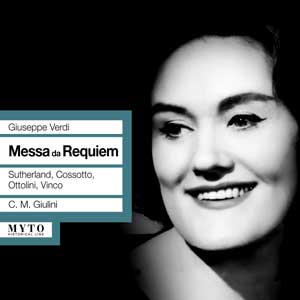This magnificent performance was recorded in Edinburgh in 1960. But caveat emptor: the sound is sub-standard by a long shot. There is a major drop-out: in the Domine Jesu, at about 2:26, there are several bars missing and the beautiful, floated soprano line simply appears in the wrong place; the section continues as it should. In addition, in the Lacrymosa, right before the soprano’s entrance, there’s a longer pause than should be (only by two or three seconds, but it seems as if something is wrong since no pause is indicated in the score). These are clearly taping/splicing issues—I have no idea how this was recorded and Myto offers no information whatsoever other than names, place, and date—and frankly, in view of how great the performance is, cruddy sound and all, they can and should be overlooked.
Giulini’s EMI recording has long been the standard for “devotional” (rather than “theatrical”) performances of this work, and despite the fact that this reading is nine minutes shorter (the briefest on disc, save for one of Toscanini’s, at 79 minutes), it still has a remarkably pious feel to it, the insanely fast Sanctus notwithstanding (2:14; Toscanini’s fastest is 2:36). It almost sounds like a stunt to see if the chorus can take it—and indeed, by the end of it they sound crazy. Although nothing seems rushed, it is very intense. The opening is hushed and almost secretive; the Dies Irae, even in poor sound, is thrilling; the Hostias is gorgeous, with a trill from the soprano like you’ve never heard; the Lux Aeterna begins in total mystery; the Libera me is dramatic and exciting but carries just the right mood-swings, ending in utter piety.
The soloists are near-divine. Sutherland sings with excellent diction and dramatic involvement, and if the low notes in her final solo are not as chesty as we might want, they are audible, clear, and right on the notes. Her repetition of “Clemens, factus” is eerily effective. Her only problem is a slight thinness of sound in her high pianissimos—but I am over-analyzing just to be cautious. Her legato is amazing. In 1960, Sutherland had everything.
And so did Fiorenza Cossotto, who at the time had absolute control over dynamics—and she never bullies. Ivo Vinco is more impressive here than I’ve previously heard him—sepulchral and fascinating. Luigi Ottolini, barely known or remembered, had a good career in Italy in the ‘60s—and he deserved it. He’s a sensitive, intelligent artist with a fine if unmemorable voice, and if he never quite reaches the heights of the others, he’s still very good. Chorus and orchestra are amazing. Can you tolerate lousy sonics for a strange thrill?
































